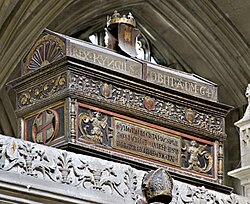Cynegils of Wessex
Cynegils (23 May 587 — 5 September 642) was the King of Wessex from 611 to his death. He was the son of King Ceol, who died when Cynegils was young. He succeeded his uncle, who was Ceol's younger brother, Ceolwulf, as king.
| Cynegils | |
|---|---|
| A Portrait of Cynegils in a Cathedral | |
| King of the West Saxons (more...) | |
| Reign | 22 April 611 — 5 September 642 |
| Coronation | 26 April 611 |
| Predecessor | Ceolwulf |
| Successor | Cenwalh |
| Issue | |
| House | Wessex |
| Father | Ceol of Wessex |
| Religion |
|
During his reign, the kingdom expanded into northern Wiltshire and Somerset, southern Gloucestershire and Oxfordshire, and western Berkshire. He is depicted as one of Wessex's greatest and most powerful kings ever.
King in Wessex
Cynegils was the grandson of Cutha,[1] the son of Ceol of Wessex[2] and probably the nephew of Ceolwulf.[3] He ruled jointly with his son Cwichelm.[4] The Anglo-Saxon Chronicle for 614 states that Cynegils and Cwichelm fought together at a place named Beandun and that they killed 2065 Welsh.[5] That was a major victory for the West Saxons.[3]
Cynegils had some setbacks, however, during the middle of his reign. His son Cwichelm sent someone to try to kill King Edwin of Northumbria.[6] When Edwin attacked Wessex in retaliation, five kings of Wessex were killed.[a][7] The Northumbrian attack weakened the West Saxon army. The Anglo-Saxon Chronicle for 628 states that Cyngils, king of Wessex, and his son Cwichelm 'fought with Penda at Cirencester and came to an agreement with him there'.[9] The 'agreement' seems to have been to give Cirencester to Penda.[10] That would bw a defeat for Cynegils and for Cwichelm and a permanent loss of Cirencester.[7]
In 634, Pope Honorius I sent Bishop Birinus to England.[3] When he reached the territory of the Gewisse (Wessex), he found them to be almost completely pagan. He began to convert the West Saxons to Christianity. In 635, Cynegils was baptized by Birinus and King Oswald of Northumbria stood as his godfather.[11] That may have been a condition of the marriage between Oswald and Cynegils's daughter, Cyneburh.[12] He gave Birinus the city of Dorchester and several churches to could convert the pagans in Wessex.[13] The conversion took some time to complete, and several kings who followed were pagan or converted to Christianity only later in their reigns.[12]
Cwichelm, his son, ruled as either co-king or underking and died in 636.[4] From then onward, Cynegils seems to have ruled Wessex by himself until his death in 643. He was succeeded by his son Cenwalh.[14] Cynegils's reign marked the turning point for Wessex from being bands of warriors to starting to be a united kingdom.[12]
Family
Cynegils had the following children:
Cynegils Of Wessex Media
Mortuary chest at Winchester Cathedral which purportedly held Cynegils's remains. It contains the bones of several individuals as the bones from it and other mortuary chests were scattered during the Civil War.
Notes
- ↑ Evidence suggests that there were several 'kings' in the West Saxon royal family at the same time. That means that the Northumbrian attack probably killed five members of the royal house of Wessex.[7] It may have been a custom of the time to give the title 'king' to all of the war leaders in the royal family.[8] But one king would be the overlord of the kingdom.[8]
References
- ↑ 1.0 1.1 1.2 1.3 1.4 Detlev Schwennicke, Europäische Stammtafeln: Stammtafeln zur Geschichte der Europäischen Staaten, Neue Folge, Band II (Marburg, Germany: J. A. Stargardt, 1984), Tafel 77; Mike Ashley, The Mammoth Book of British Kings and Queens (New york: Carroll & Graf, 1999), p. 303
- ↑ Detlev Schwennicke, Europäische Stammtafeln: Stammtafeln zur Geschichte der Europäischen Staaten, Neue Folge, Band II (Marburg, Germany: J. A. Stargardt, 1984), Tafel 77
- ↑ 3.0 3.1 3.2 Mike Ashley, The Mammoth Book of British Kings and Queens (New york: Carroll & Graf, 1999), p. 303
- ↑ 4.0 4.1 Barbara Yorke. Kings and Kingdoms of Early Anglo-Saxon England (London: Routledge, 1997), p. 143
- ↑ Benjamin Thorpe, The Anglo-Saxon Chronicle according to the Several Original Authorities: Translation (London: Her Majesty's Stationery Office, 1861), p. 19
- ↑ Benjamin Thorpe, The Anglo-Saxon Chronicle according to the Several Original Authorities: Translation (London: Her Majesty's Stationery Office, 1861), p. 20
- ↑ 7.0 7.1 7.2 Peter Hunter Blair, Roman Britain and Early England; 55 B.C.–A.D. 871 (New York; London: W. W. Norton & Company, 1966), p. 206
- ↑ 8.0 8.1 Frank Stenton, Anglo-Saxon England (Oxford University Press, 1971), p. 66
- ↑ Benjamin Thorpe, The Anglo-Saxon Chronicle according to the Several Original Authorities: Translation (London: Her Majesty's Stationery Office, 1861), p. 21
- ↑ Frank Stenton, Anglo-Saxon England (Oxford University Press, 1971), p. 45
- ↑ Benjamin Thorpe, The Anglo-Saxon Chronicle according to the Several Original Authorities: Translation (London: Her Majesty's Stationery Office, 1861), p. 22
- ↑ 12.0 12.1 12.2 Mike Ashley, The Mammoth Book of British Kings and Queens (New york: Carroll & Graf, 1999), p. 304
- ↑ Bede, Ecclesiastical History of the English People, trans. Leo Sherley Price, revsd. R. E. Latham (London; New York: Penguin Books, 1990), p. 153
- ↑ Peter Hunter Blair, Roman Britain and Early England; 55 B.C.–A.D. 871 (New York; London: W. W. Norton & Company, 1966), p. 207
Other websites
- Britannia: Kings of Wessex Archived 2013-07-27 at the Wayback Machine

